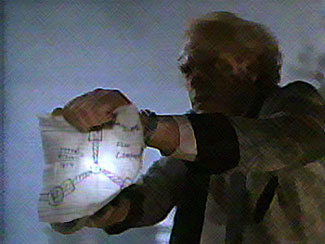
Dear Dr. Emmett L. Brown,
We have received the patent application (Appl. No. 04/567,892) for your invention, “the flux capacitor.” Having carefully reviewed all of your documentation, I regret to inform you that we are unable to grant you a patent at this time. While we were fascinated by the claim you make in the application abstract — “The flux capacitor makes time travel possible” — we were sadly disappointed by the contents of your supporting literature and scientific data. In fact, as near as we could tell, the flux capacitor appears to be nothing more than some Christmas lights arranged in a “Y” and mounted in a box.
That is not to say that Christmas lights arranged in a “Y” and mounted in a box cannot be patented. The Patent and Trademark Office issues patents for novel uses of existing devices all the time; for example, recently we issued a patent for a vacuum cleaner used to remove prairie dogs from their holes. However, I emphasize that there must be a novel use of an existing device. We see no evidence in this application that the flux capacitor does anything more than blink faster as the car in which it is situated approaches 88 miles per hour. That is not a novel use. However, you seem to feel that this represents a major scientific achievement, as you state that after reaching 88 miles per hour “the flux capacitor returns to a normal temporal position, having broken the space-time barrier.”
Dr. Brown, how does that happen? There is no explanation in your application’s documentation. In fact, other than a picture of a flux capacitor that appears to have been drawn by a concussion victim, the only substantive materials in your supporting literature are 1) schematics for “time circuits,” which appear to be little more than a calendar display operated by telephone buttons, and 2) a plutonium-fueled nuclear reactor that powers the Christmas lights.
That is perhaps the most audacious part of your application. Not only do you state that Christmas lights make time travel possible, but you then claim to need 1.21 gigawatts of electricity to turn them on. Have you considered purchasing an adapter for your car’s cigarette lighter? I have found that many simple household items that need to be plugged in function perfectly fine in my car with an adapter. Perhaps you have overstated your need for electricity. I highly doubt that Christmas lights require plutonium for power.
However, I wonder where you would have gotten plutonium to fuel test runs of your flux capacitor. Dr. Brown, I feel compelled to warn you of possible consequences for actions you may have taken while developing your invention. Under the Patriot Act, American citizens may not do business with any person or organization that poses a risk of committing or supporting terrorist acts. While I do not claim legal expertise in this field, I think it is highly possible that individuals and organizations that sell plutonium on the black market may pose a risk of committing or supporting terrorism. By purchasing plutonium from them, you could be declared a terrorist yourself and face up to $250,000 in penalties and ten years’ imprisonment. Please keep this in mind as you tinker with your De Lorean.
And as a friendly suggestion, please consider a different car for future time travel experimentation. I realize you believe that the stainless steel body of the De Lorean has a beneficial effect on the “flux dispersal,” but De Loreans are completely absent from the automotive market, making it prohibitively expensive to convert them to time machines. You might as well use a train.
Happy inventing,
Bob Gale,
Patent Inspector

